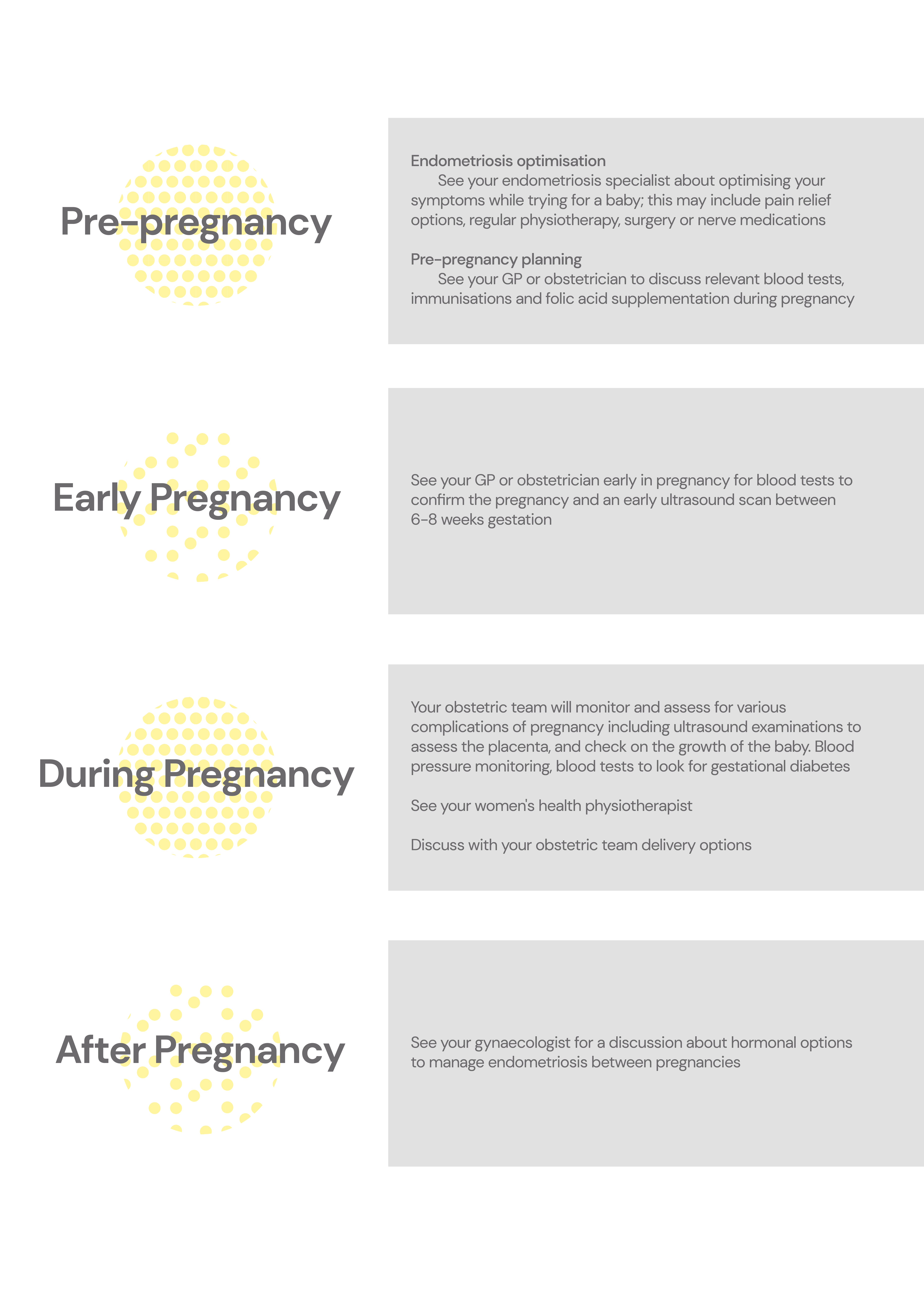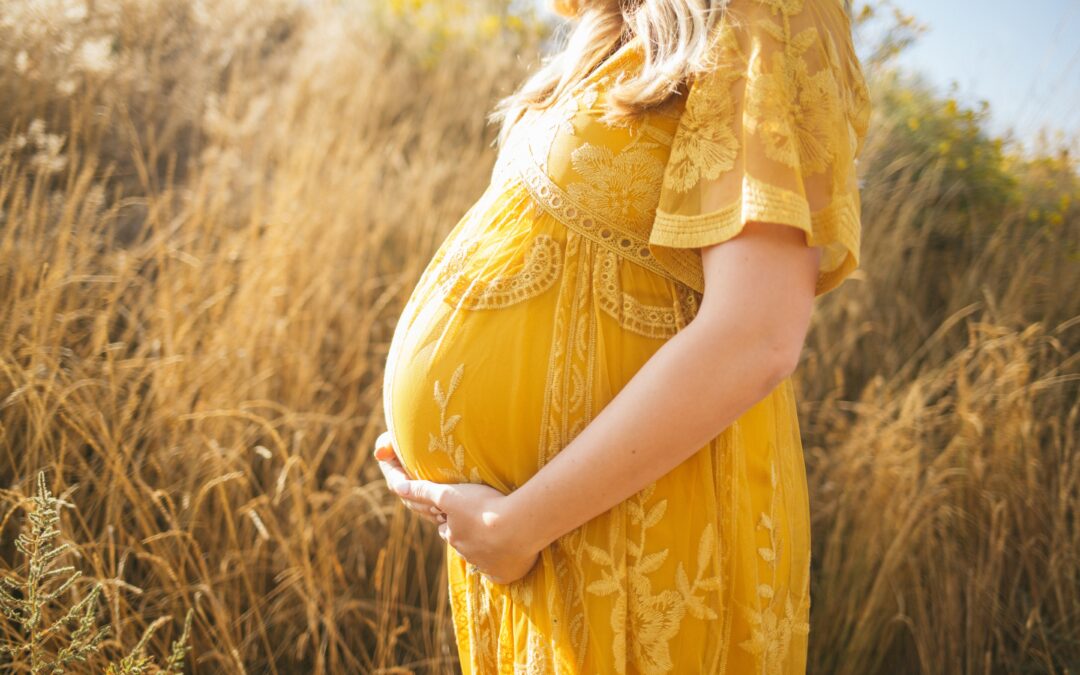For many women with endometriosis, the potential effect of the disease on their fertility is a concern. Reassuringly, the majority of women with endometriosis will be able to conceive naturally with about a third of women having fertility issues.
But what happens once you are pregnant?
Is pregnancy different for women with endo?
The old adage of pregnancy being a “treatment” or “cure” for endometriosis is now well and truly put to bed (and if your medical specialist suggests this as a way of managing your endometriosis, please consider getting another opinion!). Studies looking at endometriosis cysts in pregnancy show that these lesions may become inactive, reduce, or in a smaller percentage of women, increase in size (1). This is due to the hormonal effect of pregnancy on endometriosis. There are not many high quality studies observing pain levels in pregnancy for women with endometriosis, however data suggests that pain may be reduced for some women. There are limitations in the interpretation of these studies, as women with endometriosis are more likely to have had a laparoscopy prior to conceiving to address fertility concerns and this is also likely to help with pain. While some women will continue to have pain in pregnancy, having no periods can make pregnancy (and the postpartum period while breastfeeding) a time where pain levels are reduced. We have to remember though, that there are a number of possible causes of pelvic pain for women with endometriosis, so while pregnancy may help pain in some women, the nerves and muscles can still cause trouble. You should see your health practitioner if you are experiencing ongoing pain during your pregnancy, since this may not be related to endometriosis and may be an important pregnancy issue. An assessment and plan for the pain will be important.
Many women are concerned that there may be increased risks during pregnancy if you have endometriosis. The published research is inconsistent on many pregnancy outcomes, and reassuringly most women will have a normal and uncomplicated pregnancy. There are conflicting reports on whether miscarriage is more common with women with endometriosis compared to those without the disease. Unfortunately miscarriage is a very common complication in pregnancy for all women (occurring in about 20-25% of pregnancies). It is possible that this rate may be slightly higher for women with endometriosis but more research is required (2). Unfortunately there is no known way of preventing miscarriage, so often an early dating ultrasound scan is performed for reassurance and to monitor the pregnancy. In addition to miscarriage, in early pregnancy the other consideration for women with endometriosis is an increased risk of ectopic pregnancy (about 1:50 pregnancies) which is approximately double that of the non-endometriosis population (about 1:100 pregnancies). This is still an overall low likelihood of this complication, but if undiagnosed can lead to severe pain and bleeding that can be life threatening. This is another reason why early pregnancy ultrasound is important for women with endometriosis to make sure the pregnancy is in the correct location.
Other potential complications that are reported to be higher risk in women with endometriosis include a low placenta (called a placenta praevia – praevia is Latin for ‘going before’ so the placenta is going before the baby), smaller baby or early delivery2. Studies show that women with endometriosis have a 4-5 times higher risk of having placenta praevia than women without endometriosis2. This complication means that the placenta is positioned too close to the cervix (sometimes right over the top of it) and can cause bleeding during pregnancy and it sometimes causes a premature delivery. When it occurs, a caesarean delivery is nearly always required for safe birth of your baby and your own safety. It is not known why women with endometriosis have a higher risk of placenta praevia but it is thought that implantation of the embryo into the uterus at the very early stages may be different for women with endo. Placenta praevia is diagnosed during the pregnancy by ultrasound and if present will be monitored. Your healthcare team will routinely assess and monitor the possibility of these pregnancy issues.
So, are there any differences in how women with endo have their babies?
Statistically, women with endometriosis are reported to have higher rates of caesarean delivery than women without endo (3). The reason behind this is unknown but may relate to patient preference, high tone pelvic floor muscles or other unknown factors. A women’s health physiotherapist who specialises in the pelvic floor is a great asset in the team of professionals caring for women with endometriosis. If you don’t already have one, consider adding one to your team and they will be able to help advise you of what you can do to help prepare for the birth of your baby.
After birth, endometriosis may remain inactive for a period of time while breastfeeding. For many women, symptoms may return after the onset of periods and between pregnancies may be managed with hormonal or complementary treatments. Your endometriosis medical team can advise you on the best options for your situation.
The following figure is a flow diagram of what to expect during the various parts of your pregnancy if you have endometriosis.

Written by,
Dr Erin Nesbitt-Hawes PhD FRANZCOG B Med (Hons), member of our Clinical Advisory Committee.
Photo by Anna Hecker via Unsplash
References
1. Leeners B, Damaso F, Ochsenbein-Kolble N, Farquhar C. The effect of pregnancy on endometriosis – fact or fiction? (Review). Human Reproduction Update. 2018; 24(3):290-299, 2018
2. Leone Roberti Maggiore U, Ferrero S, Mangili G, Bergamini A, Inversetti A, Giorgione V, Vigano P, Candiani M. A systematic review on endometriosis during pregnancy: diagnosis, misdiagnosis, complications and outcomes [Review]. Human Reproduction Update. 2016; 22(1):70-103
3. Zullo F, Spagnolo E, Saccone G, Acunzo M, Xodo S, Ceccaroni M, Berghella V. Endometriosis and obstetrics complications: a systematic review and meta-analysis. Fertility Sterility. 2017; 108(4):667-672

